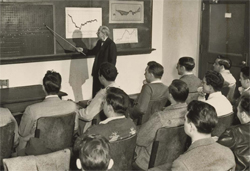
A class in Crosby Hall in the early 1950s
90 Years of Academic Excellence
Celebrating the School of Management's history
By Jacqueline Molik Ghosen
Auspicious beginnings
The year was 1923. Calvin Coolidge was sworn in as president of the United States following the sudden death of President Warren Harding. In medicine, the whooping cough vaccine was developed and, in Hollywood, German shepherd Rin Tin Tin became film's first canine star. Gasoline was 22 cents a gallon and, thanks to mass production, the price of Ford's Model T dropped to about $260.
In Buffalo, the UB Council's committee of general administration established the evening session of Business Administration and Journalism. The first classes were held downtown in Townsend Hall on Niagara Square.
The first Bachelor of Science in business administration was awarded in 1927 and the council authorized a day division of the School of Business Administration as a two-year course of study. Instruction was held in Hayes Hall on the Main Street Campus.
Edmund D. McGarry, professor of marketing and economics, recalled those days in a personal reminiscence he wrote in the 1950s.
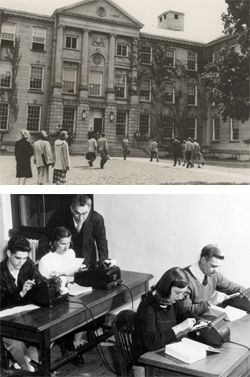
Crosby Hall (top) and one of its business classrooms in the early 1950s.
"When I arrived in 1927, there were six of us on the faculty of the business school. Dean Marsh, Dr. Epstein, Dr. Lockhart, Professor Burton, a man named Born and myself. We had an executive committee, a library committee, a graduate committee and committees ad hoc ad infinitum. But as there were only six of us, we were all on all the committees. When we changed from one committee to another, we just changed seats. We had unbound enthusiasm, for we knew we were building a new school."
The school was accredited in 1930 by the American Association of Collegiate Schools of Business, which later became the Association to Advance Collegiate Schools of Business, or AACSB International.
The following year, the school initiated a part-time MBA program and the first MBA degree was awarded to Harold A. Baker in 1933.
Construction of Crosby Hall was completed in 1932, and the building became the first permanent home of the school. The UB Council named it in honor of the contributions of William H. Crosby, a bicycle frame manufacturer who served on the UB Council and as university treasurer and chair of the finance committee.
AACSB held its annual meeting in Buffalo that spring in conjunction with the dedication of Crosby Hall, and Dean Marsh was elected president of the association. At the same time, scholastic honor society Beta Gamma Sigma installed a chapter at the school. McGarry's memoir reflects the times: "During that year, we were riding high, wide and handsome," he wrote. "That is, until fall of that year when something hit us."
Leaner times
"Up until that time, the Depression was largely a matter of mere academic interest, to be discussed in Professor Tippett's business cycle course," McGarry wrote. "In general, college teaching was regarded as a sheltered occupation. Although it was before the days of Keynes' General Theory, we believed in deficit financing. Then suddenly, one afternoon, the heads of departments were called together and told that there was not enough money to go around; the banks would refuse to lend us any more. There was no alternative but to accept a salary cut. Thus we learned the word 'retrenchment' the hard way."

A "state-of-the-art" classroom in the Jacobs Management Center, which opened in 1985.
Enrollment stabilized between 1932 and 1942, never falling below 200 and never rising above 300. "Those were lean years for the university and at times we hardly knew whether it could be held together," McGarry wrote.
In 1942, enrollment began to drop further and by the following year, selective service had reduced the student body to a mere handful. An Engineering, Science and Defense Training (ESDT) program was established.
In those days, according to McGarry, "We attempted to serve our country by giving pre-flight training to would-be officers of the air corps. The faculty had to bend its teaching of economics, labor and marketing to the Army's demand for strategy, tactics and logistics. Dean Somers taught physics. My own experience in handling the horses in field of artillery in the first World War was a little old fashioned for the Air Force, so I was assigned to teach, of all things, celestial navigation."
The turning tide
When the hosts of GIs began to return from war in 1945, the school faced different challenges. "In 1946, we had 1,364 students, six times as many as we had in 1942. The big problem was where to find teachers and where to find a place to put the students," McGarry recalled. "When the GIs left, we eventually dropped back to about 500, about double our pre-war enrollment."
In 1949, the school honored Melvin H. Baker, president and founder of National Gypsum, with the inaugural Executive of the Year award, an annual tradition that continues to this day.
The school also established a doctoral program with a specialization in business in 1949 and admitted its first two doctoral candidates in 1950. C. Perry Bliss, professor emeritus of marketing, received the school's first PhD degree in 1953.
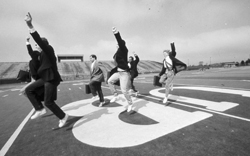
Not so serious business (1990): Members of the School of Management Precision Briefcase Marching Drill Team practice their rou-tine for the Buffalo St. Patrick's Day Parade. Sporting the "modified IBM look" with white shirts, red ties, blue jackets, blue jeans, sneakers and sunglasses, the 18- to 25-member team of undergraduate and graduate students, faculty and alumni swung their briefcases down Delaware Avenue to the tunes "Taking Care of Business" and "Working for a Living."
Other indicators of the school's growth were the 1955 endowment of the Melvin H. Baker Professorship in American Enterprise and the 1956 endowment of the M&T Professorship in Finance.
Times they are a-changin'
The 1960s brought more change to the school and the university. In 1962, the University of Buffalo became the State University of New York at Buffalo, when UB was incorporated into the State University of New York (SUNY) system. The acquisition was championed by then-governor Nelson Rockefeller, with the intent of making UB one of four major university centers in the state. UB has since earned recognition as SUNY's most comprehensive and prestigious university.
A full-time MBA program was initiated in 1963 and, on January 1, 1969, the School of Business Administration was officially renamed the School of Management. Richard Brandenburg, who served as dean from 1968 to 1976, explained the name change in a letter to alumni: "It has become increasingly clear that management concepts and tools first used in the business context also are useful in understanding and managing other types of organizations. The growing importance that public service agencies, health centers, government departments and educational institutions play in ensuring the desired quality of society has led to great demands and opportunities for diversified faculty teaching, research and consulting," he wrote, noting that changing the school's name was a logical step "to give formal recognition to these broader interests and responsibilities."
The school established an internship program in 1971 that allowed students to earn academic credit while undergoing onsite training at area firms and agencies. The program went on to become one of the largest in the country.
In 1977, under Dean Joseph Alutto, the school launched a Center for Management Development to initiate and coordinate continuing education programs for practicing managers. Alutto also established a Corporate Advisory Board in 1978.
The big '80s
The next decade was a time of considerable growth and expansion for the School of Management. A major grant in 1982 from the Jacobs family brought endowed chairs in finance and human resource management.
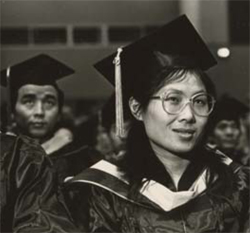
The China MBA program's first graduation ceremony, 1986
And, as the school evolved, its sphere of influence widened far beyond the local community. In 1984, the school established the first U.S. MBA program in China, with support from the Chinese Ministry of Education and the U.S. Department of Commerce. President Ronald Reagan announced creation of the program during a diplomatic trip to China that year; news of the announcement made headlines all over the world. Henry Kissinger gave the keynote address to the first graduating class in 1986 at the ceremonies held in Buffalo. Headquartered at the Dalian University of Technology, the program graduated more than 200 students before being phased out the aftermath of the Tiananmen Square protests in 1989. The last Dalian class graduated in 1991.
Thanks to a $1 million gift, the Jacobs Management Center on UB's North Campus in Amherst was officially opened in 1985 and replaced Crosby Hall on the South Campus as the School of Management's home. The building honors the late Louis Jacobs and his wife, the late Genevieve Bibby Jacobs, and their three sons, Jeremy M. Jacobs, the late Lawrence D. Jacobs and Max Jacobs.
In an innovative approach to serving the needs of the business community, the school established the Center for Entrepreneurial Leadership in 1987 and has been assisting area entrepreneurs ever since.
Approaching the millennium
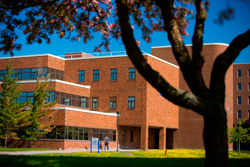
The Jacobs Management Center on UB's North Campus opened in 1985 and replaced Crosby Hall on the South Campus as the School of Management's home. Photo: Douglas Levere
The school's global reputation was burgeoning, and the early '90s were marked by the creation of several international partnerships. With funding from a series of federal grants, the school provided instructional and consulting services in Hungary. The school also partnered with UB's English Language Institute and the University of Ottawa in 1994 to help establish a new business school at the Riga Technical University in Latvia. The Riga Business School awarded the first MBA degrees the next year.
Frederick "Rick" Winter was named dean in 1994, succeeding Howard Foster, who served the school from 1990 to 1994 in what seems to have been the longest interim dean appointment in the school's history. That same year, the school introduced the Executive MBA program, and the first class of 21 students graduated in 1996.
In another global collaboration, the school reached an agreement with the Singapore Institute of Management to offer an Executive MBA in Singapore that began in 1996.
Dean Winter identified five "megatrends" that were shaping business education: globalization (and our duty to prepare students to be competitive in any market); the need for skills beyond classroom experience (with skills in communication, leadership, team building, creative thinking and understanding diversity topping the list); increased competition (including the proliferation of media rankings); strategic alliances (the need to collaborate with corporations, nonprofits, alumni and even other academic institutions); and declining state and federal support (specifically how UB, like most state universities, received less than 30 percent of its budget from the state, and that was rapidly declining).
Winter reconstituted the school's Corporate Advisory Board to include distinguished alumni as well as local executives, and renamed it the Dean's Advisory Council.
In 1997, the school's part-time MBA program was transformed into the Professional MBA program, creating a more convenient and streamlined evening program for working professionals.
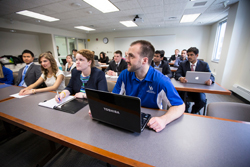
Photo: Tom Wolf
With the 1998 launch of the first-ever Executive MBA program in China, the school made a historic return to the country where it forged its reputation as a leader in international management education. Offered at Renmin University of China in Beijing, the new program was created to provide top executives with an education in Western-style management practices. All 51 students in the inaugural class were Chinese nationals.
"Our first class is representative of the complex, changing economic climate of China," said Lewis Mandell, who had taken the helm as dean that year. "We have a mix of executives from U.S. corporations, European corporations and Chinese state-owned enterprises. For business to compete in the world marketplace, it is imperative that the country's top executives learn new ways of thinking and working."
The school was praised by BusinessWeek as "a pioneer in the Asian market for management education."
Back on American soil, the school launched an innovative new competency-building course for its MBAs called Leadership PACE (Personal Achievement through Competency Evaluation). The course was created to help MBA students develop the intangible skills that make the difference between being a good executive and a great executive.
"We went directly to corporate recruiters and asked what traits they most desire in their employees," explained Jerry Newman, SUNY Distinguished Teaching Professor Emeritus and champion of the program. "Then we created a program designed to develop exactly those skills in our MBAs."
From 2002 to 2008, Dean John M. Thomas championed new curricular initiatives in technology entrepreneurship and global services and supply management. In addition, he established a new Master of Science program in the management of information technology services in India in collaboration with Amrita University and Hewlett Packard.
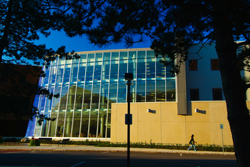
The 23,000-square-foot Alfiero Center opened in 2005 and features three high-tech lecture halls, an Internet café, a suite of offices for student organizations and multiple breakout rooms for student team meetings and group projects. Photo: Douglas Levere
Construction of the school's new addition was completed in 2005. An architectural masterpiece of glass, brick, space and light, the three-story, 23,000-square-foot Alfiero Center is entirely student-focused and is now the hub of student life at the School of Management. The center houses the academic and career development offices that assist the more than 3,000 students who enroll each year in the school. It features three high-tech lecture halls, an Internet café, a suite of offices for student organizations and multiple breakout rooms for student team meetings and group projects.
The Alfiero Center was the first academic facility at UB, and one of only a few in the SUNY system, to be funded primarily through private donations. Gifts from more than 150 alumni, friends, foundations and corporations provided the majority of the funding for the $7 million center. The center itself is named for the chair and CEO of Protective Industries, Sal H. Alfiero, and his wife, Jeanne, who made a $2 million gift to the school.
Shepherding in a new era
Arjang Assad became dean in 2008 when Thomas elected to return to his faculty role. During his tenure, Assad has led a comprehensive revision of the MBA curriculum, launched a Master of Science program in accounting and significantly enhanced the Master of Science program in finance. He also has strengthened existing programs in Singapore and India and supported efforts to enrich the undergraduate education experience.
Assad has clearly articulated three strategic areas of focus-leadership, entrepreneurship and health care management-and the school is making considerable progress in these endeavors.
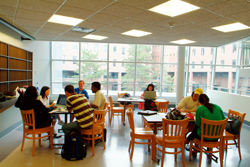
In 2010, the school launched LeaderCORE, a comprehensive leadership certification program that spans the entire two years of the full-time MBA program. Like its forerunner, Leadership PACE, the program focuses on helping students develop the core competencies considered vital by the business community for effective performance and successful leadership. In 2012, LeaderCORE was chosen as the 2012 winner of the MBA Roundtable Innovator Award.
In other innovations, the Terese Kelly Investment Group was created in 2011. The student-run, real-money investment fund educates finance students on the practical aspects of global capital markets, while providing them with real-world learning experiences in investment management.
The School of Management and UB are jointly investing in the Center for Entrepreneurial Leadership to expand both the scope and reach of its activities with an emphasis on growth-related partnerships. The school is also expanding the Panasci Technology Entrepreneurship Competition, which awards seed money and business services annually to the teams that present the best plan for the launch of a viable new business in Western New York. The program is earning status as the premier student entrepreneurship competition in the region.
In 2012, Yong Li, associate professor in the School of Management, was named director of UB's newly launched Entrepreneurship Academy, where undergraduates can share meaningful experiences throughout their college years. The academy will bring entrepreneurship to the full spectrum of UB undergraduates, allowing them to explore opportunities for including an entrepreneurial component in their career path earlier than ever before.
Moving Forward
A new initiative, the Center for Leadership and Organizational Effectiveness, will be led by Professor Paul Tesluk. With support from UB, the center will significantly advance research, teaching and outreach in the area of leadership and its impact on organizational effectiveness (see Insights).
The School of Management has made a strategic commitment to health care delivery systems by continuing joint degree programs (MD/MBA, DDS/MBA and others), as well as developing an instructional program in health care management and a new MBA concentration in health care (see Startups). The school also is partnering with the School of Medicine and Biomedical Sciences to champion the formulation of a UB-wide strategic focus in health care delivery analytics, decision-making and policy.
"I am incredibly optimistic about the school's prospects and how well our themes integrate with Realizing UB 2020, the university's strategic plan," says Assad. "As we continue to expand our horizons within the global marketplace, you can be sure that a degree from the UB School of Management is a credential that opens doors around the world."
The Deans List
{1923-present}

1923-1935
Clarence Marsh
1990-1994
Howard Foster (Interim Dean)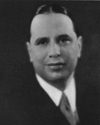
1935-1947
Ralph Epstein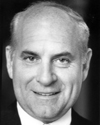
1994-1997
Frederick Winter
1947-1960
Harold Somers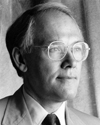
1997-1998
John Thomas (Interim Dean)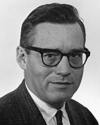
1960-1963
Arthur Butler (Acting Dean)
1998-2001
Lewis Mandell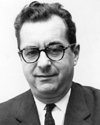
1963-1964
Simon Rottenberg
2001-2002
Jerry Newman (Interim Dean)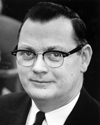
1964-1968
James Schindler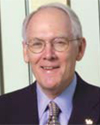
2002-2008
John Thomas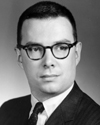
1968-1976
Richard Brandenburg
2008-present
Arjang Assad
1977-1990
Joseph Alutto (Acting Dean for first year)
CEL: An Anniversary within an Anniversary
In addition to the 90th anniversary of the School of Management, 2013 marks the 25th anniversary of one of the school's most successful endeavors, the Center for Entrepreneurial Leadership (CEL).
For the past quarter-century, the CEL has motivated, guided and empowered business owners to overcome challenges and increase their success through peer-based and mentor-driven programming.
The success of its programs is evident in the more than 900 CEL alumni who employ approximately 22,000 Western New Yorkers, with businesses worth more than $2 billion to the local economy.
The 10-month Core program remains the CEL's most popular offering, but several other programs have emerged through the years to address a variety of entrepreneurial avenues, such as the Allstate Minority and Women Emerging Entrepreneurs program, the Henry A. Panasci Jr. Technology Entrepreneurship Competition and several recently added programs focusing on life sciences and high-tech fields.
"The center has grown significantly over the past few years with a financial investment of $525,000 from the university and the School of Management," says Tom Ulbrich, CEL executive director. "We have greatly increased the number of people we serve annually, in addition to interacting with more than 350 local business leaders who volunteer to share their expertise as mentors, reactors and speakers in our programs."
In June, the CEL celebrated its anniversary with a cocktail reception and program attended by more than alumni, friends and UB faculty and staff.
For more information, visit mgt.buffalo.edu/cel.
